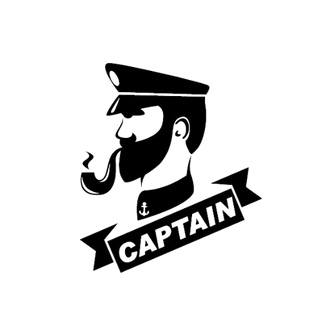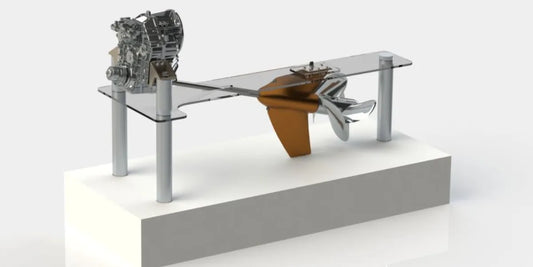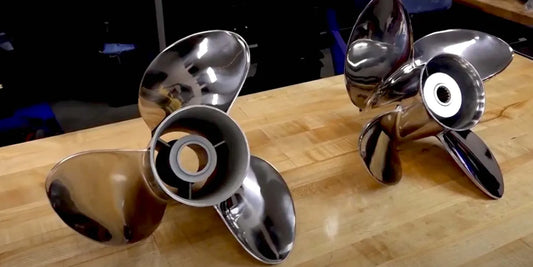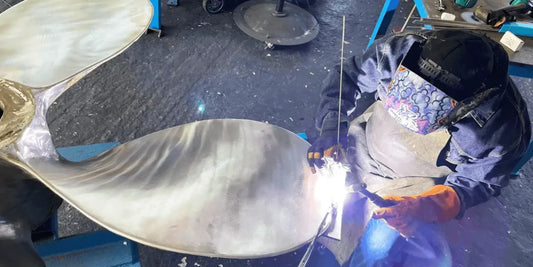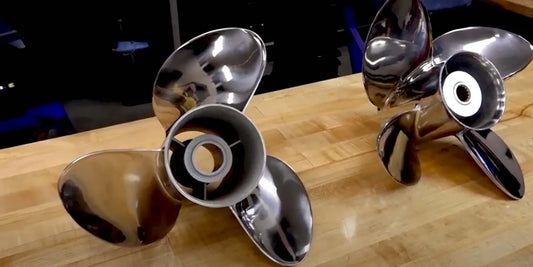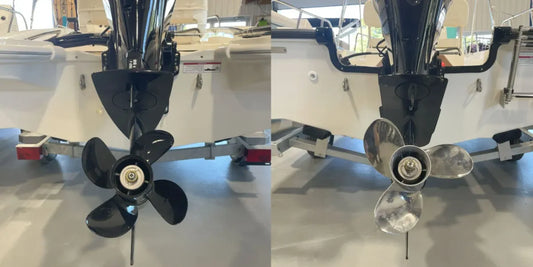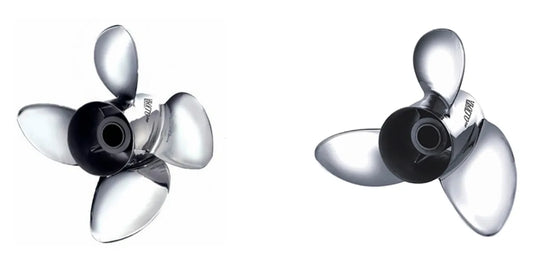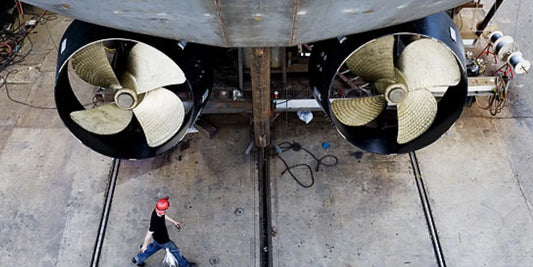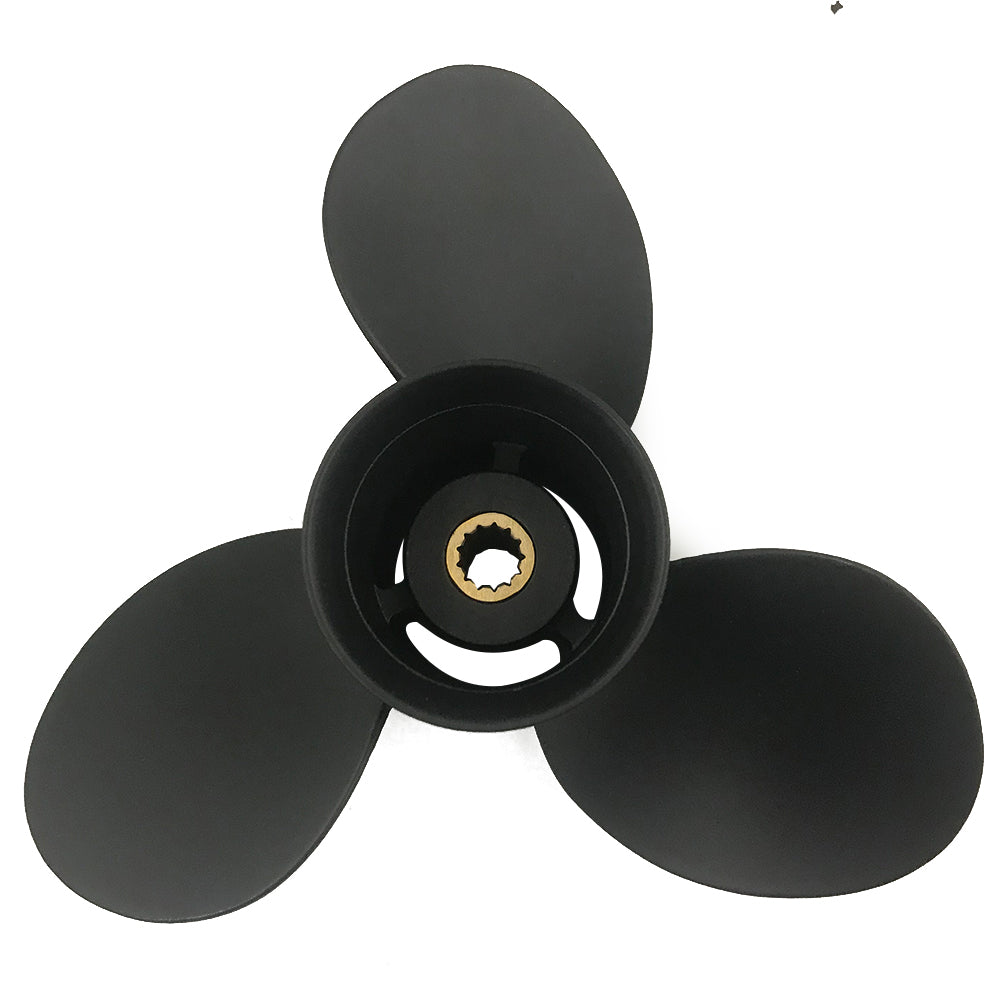When thinking of optimizing vessel performance, never mind the wrong propeller choice. Among the commonplace offerings, the 3-blade versus 4-blade conversation stands paramount for any boatman or watercraft enthusiast. Is the 4-blade prop better than the 3-blade? Or does it all just depend on what your boat needs and how you use it? That big query is dug into in this article, revealing both options' advantages and disadvantages. Whether you want better handling, top speed, or fuel economy, it all gets out in the open-the technical side and practical side-so you can make an informed decision. In the end, you will understand which propeller can help you meet your boating goals and how each can weigh in on your overall standing in the water.
Understanding Propeller Basics

What Is a Propeller?
A propeller is a mechanical device designed to generate thrust by converting rotational motion into linear motion in a fluid, such as water or air. The blades of a propeller are arranged around a central hub and work by imparting force onto the surrounding medium, which, in the case of boats, is water. The blades are shaped to create a pressure difference across them when rotated; hence, depending on the direction of rotation, the propeller is either driven forward or backward. Propellers exist in different designs, sizes, and materials to suit particular purposes, such as maximum speed with efficient thrust application or maximum load application. A glance into how a propeller works will help in choosing the right propeller for your vessel, giving you the best performance rating and fuel mileage.
Types of Propellers: 3-Blade vs 4-Blade
Performance requirements, speed, and application are considerations when choosing between a three- and four-bladed propeller. A 3-blade propeller is the choice when one wants to achieve higher top-end speeds and further maximize fuel efficiency. Since it creates the least drag among other types due to the number of blades, it is used on vessels that require responsiveness and speed, such as speedboats or performance fishing boats. Furthermore, 3-blade props provide smoother acceleration and are preferable under lighter loads.
On the flip side, a 4-blade prop exerts more thrust at low speeds and offers better handling. It, therefore, suits heavier boats or those with hatch management requiring fine maneuvering-type pontoon boats or towing vessels. In choppier waters, these four-blade props tend to enhance stability by giving a smoother ride. Since these propellers allow the ship to maintain RPM at slow speeds even under challenging conditions, they lack a rating for top-end speed compared to their counterparts with three-blades. Hence, they add dependability.
Knowing these differences, boaters set performance according to parameters whereby speed, handling, and efficiency ratings contribute to their make and watercraft.
Blade Number Versus Performance
The more blades a propeller has, the more that factor interferes with the efficient translation of engine power into the movement of a boat through water. With 4 or 5 blades, the increased surface area contact means smoother acceleration and better stability. Hence, they work great with heavier boats or those that must operate in choppier waters with consistency. These fewer blades sometimes offer the propeller with its greatest speed and agility, the 3-blade is often the choice for small lighter boats or any boat where top-end speed stands paramount.
Knowing the difference offers a good basis to enhance one's ability in selecting a propeller suited to his or her particular needs, be it towing, cruising, or racing. Hence, the blade count accomplishes the delicate balance between efficiency, stability, and speed, ensuring that the agreed functionality of the propeller will stand up well in any maritime situation.
Efficiency and Performance Comparison

Fuel Efficiency: 3-Blade vs 4-Blade
About fuel efficiency, 3-blade and 4-blade propellers offer different advantages depending on the nature of the boat and its operations. At higher speeds, a 3-blade propeller can generally provide better speed and fuel efficiency due to lowered drag in water, which suits boats where the maximum performance is sought, with steady throttle stations held for long hours of cruising.
This propeller tends to work best in the medium-speed range, where it must grip well with smooth motion. Such a design helps provide minimal slippage and high accuracy in power transmission and fuel consumption under load or during maneuvering, be it towing or crossing rough waters. There will be a bit of fuel consumption at high speed, however, because drag increases. But in an overall picture of efficiency over several speeds, this makes it a good choice for boats that must perform well in a wide range of conditions, such as wakeboarding or fishing.
In this way, knowing the trade-offs between speed, stability, and operational efficiency helps operators choose the propeller that best matches their performance goals and fuel consumption.
Speed and Acceleration Factors
Speed and acceleration are variables influenced by events such as propeller pitch, blade material, and the entire boat design system. Propeller pitch plays a prominent role; high-pitch propellers tend to give higher top speeds but tend to result in sluggish acceleration due to the engine exerting massive effort to push through water. Low-pitch propellers, on the contrary, exert high acceleration but pose limitations in terms of top speed.
The propeller's material also affects speed and efficiency. Light materials such as aluminum are fit for casual use, with good speed that does not delay the engine. Stainless steel propellers, while being heavier, wear better at higher speeds, making them suitable for the choice of competitive or performance boating.
On the other hand, the shape of the hull and the weight distribution will directly determine the propulsion efficiency of the watercraft; a streamlined hull increases speed by lessening drag, favoring acceleration and maintaining speed, whereas a heavier or wider hull will sacrifice its ability to produce speed with some degree of stability. So, by intelligently adjusting the weight and its distribution aboard or choosing prop size depending upon water condition, one can always manipulate speed and acceleration to suit their purpose.
Handling and Maneuverability
Maneuverability in a vessel is a very crucial parameter for its overall safety and performance. It is basically how the boat responds to given inputs from the steering or any other control. For instance, deep-V hull boats usually make a boat ride smoother in harsh winds and waves and therefore require precise inputs from the steering, whereas flat hulls provide better stability at the cost of less nimbleness. On the other hand, the incorporation of modern technology has dramatically enhanced the precision and operational ease. Docking simply becomes another matter, and maneuvering about confined spaces proves to be a cinch with docking. Enhanced handling in varying water conditions makes things easy indeed. When all such elements are taken into consideration for optimization, the boater gains the confidence and command to adapt to an unanticipated environment.
Choosing the Right Prop for Your Boat

Factors Influencing Prop Selection
Choosing the exact prop for your boat does require an understanding of those very important performance factors that serve to either compound or lessen efficiency and handling, and the complete boating experience. One of the significant things considered when deciding on the prop is the kinds of activity the boat is engaged in, for example, cruising, watersports, or fishing, with every different activity requiring different performance characteristics. Compatibility with the engine is the next factor that constitutes an essential parameter to check: the propeller must be able to transmit power efficiently, given the engine horsepower and gear ratio.
Additionally, propeller materials, typically aluminum or stainless steel, affect durability and performance; steel lasts longer and performs better, but it demands a higher price. The pitch and diameter determine acceleration, speed, and fuel consumption; in light of this, these should be adjusted in accordance with your boating requirements. Other factors include the number of blades, which affects speed and handling, and water conditions, such as those present in shallow or debris-ridden areas, which might force consideration of a specialized propeller. Hence, after balancing all the intricacies on this list, the waterman shall be bestowed with smooth operation, fuel savings, and satisfaction on the waters.
Boat Type and Intended Use
The boat used and its intended use are two significant factors in the choice of a propeller. For example, recreational boats use cruising as the mode of operation and may place emphasis on fuel efficiency and a smooth ride; hence, a propeller accounting for moderate speed and stability is desirable. High-performance boats used primarily for water sports or racing will require propellers built for speed and quick acceleration. Those propellers will have more aggressive blade angles and will be made of materials that can withstand extremely demanding conditions. Fishing boats operating in shallower waters, often filled with debris, may require special propellers designed to avoid damage, such as weedless or tough aluminum finishes. The knowledge of your boat's primary use helps in choosing a propeller that complements the task and helps enhance performance.
The weight and size of boats have a lot of bearing in choosing a suitable propeller. Larger vessels, such as pontoon boats or family cruisers, need some thrust from the propellers to work the additional weight with ease, in favor of the larger diameter propellers with a more moderate pitch. Smaller vessels, giving a great deal of agility and quick maneuverability, tend to go for light propellers. Whether you are rolling in the calm lakes, crashing coastal waves, or towing some friends behind on water skis, choosing the right propellers for your boat type in accordance with its working needs will always provide better control, less engine strain, and a much better boating experience.
Weight and Power Considerations
Weight and power considerations are of paramount significance during propeller selection if one wishes to buy a boat with optimal performance. A heavy ship would necessitate the fitting of propellers that can generate high thrust levels as compensatory forces against making the boat carry other load requirements. A large-diameter propeller with a small pitch angle would represent an appropriate choice for a bigger vessel laden with more weight, in that it provides steady propulsion without putting any undue stress on the engine. Conversely, lighter propellers would perform with a higher pitch for greater speed and acceleration, thus accompanying their moderate total weight and power requirement. Conversely, aligning the engine output power with the weight variation of the boats will always guarantee energy efficiency, fuel consumption, and performance, all in a harmonious unit.
Common Myths About Propeller Blades

Disproving Misconceptions
One preconceived notion is that more blades mean good performance. The additional blades could add more thrust and reduce vibration, but drag could be increased along with them, eventually decreasing efficiency. More or fewer blades depend on the use case of the boat, engine power, or water conditions. High-speed vessels usually demand fewer blades to avoid drag, whereas big boats oriented toward stability and towing prefer more blades to make the operation smooth.
Another misconception is that one propeller fits all boats. The selection of a propeller depends heavily on hull design, engine capability, and normal water conditions. A propeller optimized for one boat may cause undue straining of the engine or not enable the other to attain optimum speeds. Customization ensures that performance enhancement or the efficiency of a particular vessel meets its specific needs.
Finally, some believe stainless steel propellers outperform aluminum ones in all ways. Stainless steels offer the durability required for high-speed applications; aluminum propellers, conversely, are lighter, cheaper, and to a large extent applicable in recreational applications. The choice of material thus ultimately comes down to boat application and budget.
Expert Opinions About Blade Efficiency
Efficiency in blade design is an essential factor for vessel performance optimization. Expert opinions say that the number of blades, the general shape, and the pitch all strongly affect efficiency. For instance, three-blade propellers are generally considered suitable for speed and performance, therefore, being used in high-speed recreational boats. At the same time, four and five-prop systems are touted for smoother operation and better thrust in towing and/or heavy-load applications.
Another point mentioned by marine engineers is the importance of blade cupping-a slight curvature along the blade's edge- that improves grip on the water, consequently creating efficiency at greater speeds. Manufacturers have also been able to advance with mathematical developments in CFD simulations, fine-tuning the blade design with extreme effectiveness by eliminating drag and optimizing propulsion. Thus, with customized options, boat owners and operators can maximize efficiency based on the vessel-specific power, weight, and operating conditions tailored precisely to their needs.
Boat Owner's Experiences from the Field
Mystery has it that their names have regularly been quoted in history, to emphasize the transformation brought about by modern technology in propellers in the on-water adventures of owners. For instance, they allege a marked improvement in fuel efficiency after the changeover to precision-made propellers that were fully customizable to meet their precise needs for a vessel. Consequently, one owner of a midsized fishing boat stated that some CFD optimization on a new propeller they installed had drastically cut down the fuel costs on their long-distance excursions. Another yacht owner noted that the latest designs of the blades allowed for almost negligible cabin vibrations, thus offering an otherwise very smooth cruising experience even at greater speeds.
Beyond performance, some also emphasize the aspects of durability and dependability of new materials applied in propeller manufacture. Several operators in commercial settings acknowledge the reduced maintenance requirements, which save time and operational costs over greater stretches. With firsthand testimonials backing up the gains associated with some of these advancements, it stands to reason that the advanced propeller technology has been making significant changes in the recreational and professional boating communities.
Maintenance Tips for Propellers

How to Care for Your 3-Blade and 4-Blade Props
In keeping the 3-blade and 4-blade propellers in excellent condition, it is a constant maintenance procedure to make sure that performance and long life are optimized. For one, I personally make it a practice to have a visual inspection of my boat propeller after every outing. I look for damage, such as nicks, cracks, or bent blades. These damages greatly affect the efficacy with which the boat operates and how it handles. When I find any damage, I want to get the repair done right away: minor dents can be fixed, but major problems should be dealt with by replacing the propeller to prevent further damage.
Using a cleaning method is also an essential factor in the care of the propeller. I constantly clean off debris such as fishing lines, seaweed, or barnacles that may accumulate around the blades or shaft. Most charts of grime could be cleaned by a warm mix of water and mild soap or detergent without damaging the propeller material. For harder build-ups, however, I resort to a plastic scraper and am careful not to scratch the surface. Cleanliness of the propeller prevents undue wear and tear and maintains fuel efficiency and smoother operations.
Finally, I regularly check and lubricate the hardware. The activity ensures that the propeller's hub gets inspected for shaft grease at times so that it does not seize up or corrode when exposed to seawater. Also, I verify bolt tightness and security without overtightening, as this will ruin the threads. These simple maintenance tasks maintain the continual performance of my three- and four-blade props while saving me from costly repairs and enhancing my boating pleasure.
Signs of Wear and When to Replace
Though we talk a lot about proper maintenance for boat propellers, they eventually suffer wear, compromising their performance and efficiency. I keep careful watch for the familiar signs: chips on a blade, cracks, or bending of one or more blades. Any kind of physical damage causes improper balancing, which results in vibrations felt throughout the hull and further diminishes propulsion efficiency. Sometimes I find that the boat cannot reach its often-advertised top speed, or sometimes the engine works too hard; those are generally telltale signs of an inefficient or damaged propeller.
Another thing I like to inspect is corrosion, especially in saltwater environments. Even with coatings applied to protect them and a buildup of grease regularly, once the elements get to the prop material, corrosion sets in, which means the structure will weaken and thus become more prone to failure. Abrasive wear is also something I check around the hub and spline areas that are critical in the transfer of engine power efficiently to the propeller. Once the hubs start slipping, it's an indication that they may need to be replaced.
I change the propeller only if accumulated damage makes a serious dent in my boat's performance or fuel efficiency. Selecting a replacement, I check carefully that its size and pitch fit my boat's engine specifications and the actual operating conditions. Sometimes a bit of improvement here and there can work better: using stainless steel for durability or simply switching to a 4-blade for smoother operation. Staying ahead of signs of wear assures safer boating and could prevent one from bigger mechanical problems in the future.
Proffered Suggestions During Propeller Installation
The installation of the new propeller requires careful attention to precision, because only then will it perform well and stay strong for a long time. I always start by carefully inspecting the propeller shaft for any signs of damage or corrosion, or perhaps debris that might interfere with a proper fitting. Getting a nice cleaning for the shaft is non-negotiable; washing away old grease and dirt makes for a nice fit and a tight seat. When mounting, I finish by applying high-quality marine-grade grease on the shaft itself, so that it will not corrode and also to ease any future removals.
Ensure proper alignment during installation. I ensure the propeller is fully seated on the shaft with the key or pin fully aligned in the keyway. One must never over-tighten or use force to get the propeller on; use a torque wrench to tighten the nut according to the manufacturer's recommended specifications. Locknuts or cotter pins are used to secure the propeller in place. If this is left undone, vibrating may occur, or the propeller may spin into the water, causing major mechanical problems.
Finally, I proceed to complete testing. Once mounted on the vehicle, the engine must be run gently at low speeds to identify any strange vibrations or noises that may translate into misalignment or damage upon installation. Routine inspection and maintenance are, of course, necessary for propeller longevity, so I tend to inspect wear or damage every other trip or so. My adherence to these will ensure my boat runs well and efficiently, while also significantly reducing any unplanned downtime in the water.
Reference Sources
-
3 Blade vs. 4 Blade Propeller - Michigan Wheel
Discusses the advantages of 4-blade props, including their power, vibration absorption, and performance differences compared to 3-blade options. -
4 Blade vs 3 Blade Propeller - The Hull Truth
Explores how 4-blade props operate at lower RPMs and their efficiency compared to 3-blade propellers. -
3 Blade vs. 4 Blade Propellers - Boatsetter
Highlights the performance trade-offs, including speed and efficiency, between 3-blade and 4-blade propellers.
Frequently Asked Questions (FAQs)
What are the effects of the 4-blade on the boat's performance?
Generally, a 4-blade propeller imparts high performance at low speeds and hole shots because of greater blade surface area, hence the increased torque. More torque fits with greater acceleration, which is suitable for tubing or skiing. A 3-blade prop may offer better speed efficiency, but a 4-blade will better accelerate (or hole shot) and could decrease vibration. So, depending on the performance desired of the boat, the choice of prop could become either a 3-blade or a 4-blade. A 4-blade prop can also better maintain RPM under load, therefore making it more suitable for recreation boats.
What are the advantages of using a 4-blade prop over a 3-blade prop for high-performance applications?
In high-performance applications, a 4-blade prop can allow for greater hold in the water, resulting in quick acceleration and top-end speeds. The fourth blade makes the prop more efficient in varying RPMs so that the engine is better able to capitalize on its horsepower. Whereas a 3-blade prop may be lighter and create less drag at higher speeds, a 4-blade will provide more torque and less vibration. Furthermore, with an adequate number of blades, one can evenly distribute the load, which tends to lower stress on the motor and might also improve fuel mileage. Naturally, the choice may depend mostly upon what needs to be accomplished with the engine and the horsepower involved.
Are 3-blade props more efficient at WOT than 4-blade ones?
At full throttle, depending on the boat, a 3-blade prop may give slightly better efficiency while trying to attain maximum speed. This is because fewer blades translate into less drag, so that speed could be higher in some cases. On the other hand, a 4-blade prop could retain its efficiency through the increasing lift and grip as some conditions vary in the water. More so, while a 3-blade prop would be better for long-distance high-speed rambling, the 4-blade prop will balance the performance with additional torque and stability. Depending on the kind of work planned and the specific currents on the existing prop itself, these factors must be considered.
How do the diameter and pitch of a 4-blade prop affect its performance compared to a 3-blade prop?
The diameter and pitch of a propeller largely determine the propeller's performance. Generally, a 4-blade prop can be designed for a larger diameter, hence providing higher lift and efficiency at lower speeds. Thus, it is possible to change the pitch to fit the optimal motor RPM range so that the engine works at its best efficiency. When going head to head, compared to 3-blade propeller, the larger blade area of the 4-blade can accelerate better and give the vessel a better hole shot. But the pitch becomes a deciding factor, as a higher pitch will diminish the low-end torque. So, these are things that need to be balanced to know what is the best suitable prop for your vessel.
Does a 4-blade prop reduce vibration better than a 3-blade prop?
Yes, a 4-blade prop can often reduce vibration much better than one with 3 blades. The extra blade helps to balance the load more evenly across the propeller, which, in turn, results in a smoother ride. This is best for recreational boats or boats that are used for skiing/tubing, where vibration plays a role in comfort and performance. With less vibration, a 4-blade prop would allow for better life expectancy of the motor as well as other components, though the benefits will come only when the prop is correctly matched to the vessel's engine.
What factors do you have to look into when determining whether to select a 3-blade or 4-blade prop for your boat?
There are certain factors to consider when deciding between a propeller with three blades or one with four blades. The type of boating involved in the work, the horsepower of the motor, and the desired characteristics of performance. If you are interested in high RPM speed and performance, a 3-blade prop may work best for you. Water skiing or tubing activity may require 4-blade props having better acceleration and torque. Weight of the vessel, the kind of water in which it navigates, and any specific need for performance should go into the account. Evaluating your current proposal and understanding what your boat wants to accomplish with performance will greatly help in deciding what to go with.
